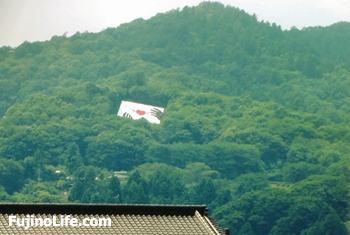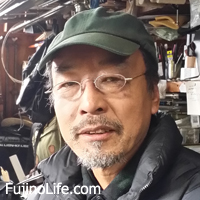The faces of Fujino
Introducing  Masa-san:
Masa-san:
Masa-san’s Love Letter is the most prominent and identifying work of art in Fujino. It spans 17 meters high and 26 meters wide on a mountain clearly visible from the Fujino train station and the Chūō Expressway. The Love Letter isn’t Masa-san’s only gigantic composition. In 1988, a year before making the Love Letter, Masa-san placed eyes on another mountain further south. More recently, he created a half-picture frame that symbolizes an entryway into the artistic world of Fujino. Each artwork has a message about humanity, nature, care, consciousness, and the universe. If you are fortunate to spend some time with him, Masa-san is happy to share the stories behind his creations.
The commonality between Masa-san’s artwork is the large size. Masa-san has an uncanny talent to view up close a large assembly of pipes, clamps, tarps, hoses, and other construction materials, and arrange three-dimensionally in his mind how they would appear from multiple distant angles. Masa-san’s designs consider a detailed assembly method to ensure that the materials can be hand-carried up the mountain, parts to be displayed fit through background support structures, and the parts can be manually hoisted into place in the middle of a forest. On a worksite, Masa-san is able to quickly eyeball whether a distance is correct within a few millimeters and whether an angle is accurate within a degree. His skill comes from nearly 50 years of practice.
Masa-san believes the condition of the mountain art is a reflection of the societal care for our surroundings. Many years ago, the Love Letter was disintegrating. Nobody seemed to notice or care that the piece of art looked like a heap of rubbish on our mountain. People had forgotten to be attentive to their surroundings. Today, the Fujino community is positive. People notice the state of things. People care about their environment, their community, and each other. When my artwork needs maintenance, people notice and volunteer their time to help me repair.
Tell us something about yourself.
When I was a child growing up in Yokohama, the coastline was sandy beach. Now it’s unrecognizable concrete, warehouses, and apartment buildings. I moved to a quiet town north of Yokohama, but then a major highway was built right through the middle. I moved again, this time to Fujino. Since coming to Fujino in 1955, the nature has not changed, and I think that’s wonderful. I am just a speck in the universe, but I hope my environmental art does a little to influence society to remember to cherish nature.
What is something special that you like about Fujino?
Fujino is a “functional laboratory” where I can experiment with art, agriculture, and other aspects of life, and witness the results. In Fujino, I can live in harmony with nature in a clean environment with few pollutants. We grow our vegetables without pesticides and learn the cycle of forest animals and insects. We can tap fresh spring water. I feel that in Fujino, I can live in reality.
Is there anything else you would like to share?
Our primary worries are for ourselves and our families. Concerns about nature and the environment are secondary. I want to raise awareness that nature and environment are priorities because without environmental care, we all lose our habitat.
Workshops
I will take you on a journey of connection-with-nature by telling you the stories behind my artwork. Some of my perspectives might be complex and difficult to express with words, but I would like to share with you my observations and feelings about the evolution of human consciousness and how I represent it in my art. Please join me on my Art Messages Tour.
See other Fujino residents.
